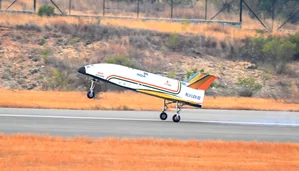India took a significant step forward in its quest for a reusable launch vehicle with the successful test landing of RLV LEX-2, known as ‘Pushpak’. The Indian Space Research Organisation (ISRO) conducted the test landing at the Aeronautical Test Range (ATR) in Karnataka’s Chitradurga.
The RLV LEX-2 showcased its autonomous landing capability from off-nominal initial conditions after being released from a helicopter. The winged ‘Indian space shuttle’ was lifted by an Indian Air Force helicopter and released from a height of 4.5 km.
After release, Pushpak autonomously approached the runway with cross-range corrections and successfully landed using its brake parachute landing gear brakes and nose wheel steering system. This marks ISRO’s second successful test landing of its RLV.
ISRO’s mission simulated the approach and high-speed landing conditions of an RLV returning from space, validating its indigenously developed technologies in navigation, control systems, landing gear, and deceleration systems. The reuse capability of flight hardware and systems was also confirmed.
The collaboration between ISRO’s Vikram Sarabhai Space Centre (VSSC), Liquid Propulsion System Centre, ISRO Inertial Systems Unit, and other government agencies played a crucial role in achieving this milestone. The success paves the way for future orbital re-entry missions.
Dr. S. Unnikrishnan Nair highlighted the importance of mastering terminal phase maneuvering, landing, and energy management in a fully autonomous mode. The team, led by Programme Director Sunil P. and Project Director J. Muthupandian, achieved a critical step towards orbital re-entry missions.

 Google I/O 2024 Discussed In Detail: Gemini AI Comes With New Capabilities
Google I/O 2024 Discussed In Detail: Gemini AI Comes With New Capabilities  ChatGPT-4o: OpenAI Rolls Out Faster and Enhanced Version for Free and Paid Users; Deets Inside
ChatGPT-4o: OpenAI Rolls Out Faster and Enhanced Version for Free and Paid Users; Deets Inside Choosing the Right CPQ System for Your HVAC Business: Key Considerations
Choosing the Right CPQ System for Your HVAC Business: Key Considerations What if Custom Mouse Pads Start Peeling or Fraying?
What if Custom Mouse Pads Start Peeling or Fraying? Exploring the Crucial Role of Reddit MLB Streams: Enhancing Access to Live Baseball Action
Exploring the Crucial Role of Reddit MLB Streams: Enhancing Access to Live Baseball Action Elevate Your Store: How to Automate Shopify
Elevate Your Store: How to Automate Shopify Apple Expected To Unveil New iPads At Let Loose Event On May 7: What We Know
Apple Expected To Unveil New iPads At Let Loose Event On May 7: What We Know FaZe Clan Initiates Reboot with Additional Layoffs and Updates to Esports Teams
FaZe Clan Initiates Reboot with Additional Layoffs and Updates to Esports Teams